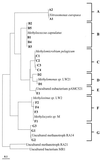Comparison of pmoA PCR primer sets as tools for investigating methanotroph diversity in three Danish soils
- PMID: 11525970
- PMCID: PMC93094
- DOI: 10.1128/AEM.67.9.3802-3809.2001
Comparison of pmoA PCR primer sets as tools for investigating methanotroph diversity in three Danish soils
Abstract
Three particulate methane monooxygenase PCR primer sets (A189-A682, A189-A650, and A189-mb661) were investigated for their ability to assess methanotroph diversity in soils from three sites, i.e., heath, oak, and sitka, each of which was capable of oxidizing atmospheric concentrations of methane. Each PCR primer set was used to construct a library containing 50 clones from each soil type. The clones from each library were grouped by restriction fragment length polymorphism, and representatives from each group were sequenced and analyzed. Libraries constructed with the A189-A682 PCR primer set were dominated by amoA-related sequences or nonspecific PCR products with nonsense open reading frames. The primer set could not be used to assess methanotroph diversity in these soils. A new pmoA-specific primer, A650, was designed in this study. The A189-A650 primer set demonstrated distinct biases both in clone library analysis and when incorporated into denaturing gradient gel electrophoresis analysis. The A189-mb661 PCR primer set demonstrated the largest retrieval of methanotroph diversity of all of the primer sets. However, this primer set did not retrieve sequences linked with novel high-affinity methane oxidizers from the soil libraries, which were detected using the A189-A650 primer set. A combination of all three primer sets appears to be required to examine both methanotroph diversity and the presence of novel methane monooxygenase sequences.
Figures


References
Publication types
MeSH terms
Substances
Associated data
- Actions
- Actions
- Actions
- Actions
- Actions
- Actions
- Actions
- Actions
- Actions
- Actions
- Actions
- Actions
- Actions
- Actions
- Actions
- Actions
- Actions
- Actions
- Actions
- Actions
- Actions
LinkOut - more resources
Full Text Sources
Other Literature Sources

